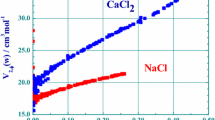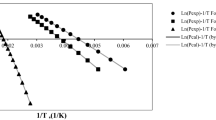Abstract
Isothermal vapor-liquid equilibrium data of binary mixtures containing ionic liquids are correlated using three activity coefficient models: UNIQUAC, Wilson, and NRTL. Twenty binary systems taken from the literature were selected for this study. A genetic algorithm is used to determine the interaction parameters for the three models. The results given by the three models have been compared with experimental data, and show that the UNIQUAC model is the best method to correlate and predict the vapor-liquid equilibrium of this type of systems.
Similar content being viewed by others
References
Lazzús, J.A., Estimation of Density as a Function of Temperature and Pressure for Imidazolium-Based Ionic Liquids Using a Multilayer Net with Particle Swarm Optimization, Int. J. Therm., 2009, vol. 30, pp. 883–909.
Yang, J., Peng, C., Liu, H., and Hu, Y., Calculation of Vapor-Liquid and Liquid-Liquid Phase Equilibria for Systems Containing Ionic Liquids Using a Lattice Model, Ind. Eng. Chem. Res., 2006, vol. 45, pp. 6811–6817.
Heintz, A., Recent Developments in Thermodynamics and Thermophysics of Non-Aqueous Mixtures Containing Ionic Liquids: A Review, J. Chem. Thermodyn., 2005, vol. 35, pp. 525–535.
Wang, T., Peng, C., Liu, H., Hu, Y., and Jiang, J., Equation of State for the Vapor-Liquid Equilibria of Binary Systems Containing Imidazolium-Based Ionic Liquids, Ind. Eng. Chem. Res., 2007, vol. 46, pp. 4323–4329.
Kato, R. and Gmehling, J., Measurement and Correlation of Vapor-Liquid Equilibria of Binary Systems Containing the Ionic Liquids [EMIM] [(CF3SO2)2N], [BMIM] [(CF3SO2)2N], [MMIM][(CH3)2PO4] and Oxygenated Organic Compounds Respectively Water, Fluid Phase Equilib., 2005, vol. 231, pp. 38–43.
Nebig, S., Bölts, R., and Gmehling, J., Measurement of Vapor-Liquid Equilibria (VLE) and Excess Enthalpies (H E) of Binary Systems with 1-Alkyl-3-methylimidazoliumbis(trifluoromethylsulfonyl)imide and Prediction of These Properties and γ∞ Using Modified UNIFAC (Dortmund), Fluid Phase Equilib., 2007, vol. 258, pp. 178–188.
Orbey, H. and Sandler, S.I., Modeling Vapor-Liquid Equilibria. Cubic Equations of State and Their Mixing Rules, USA: Cambridge Univ. Press, 1998.
Walas, S.M., Phase Equilibria in Chemical Engineering, Storeham: Butterworth Publ., 1985.
Gmehling, J., Onken, U., and Arlt, W., Vapor-Liquid Equilibrium Data Collection. DECHEMA, Frankfurt: Verlag+Druckerei Friedrich Bischoff, 1982.
Lazzús, J.A., Prediction of Sublimation Pressures from SCO2+Hydrocarbon Systems Using a Particle Swarm Optimization, J. Eng. Therm., 2009, vol. 18, pp. 306–314.
Domańska, U., Królikowski, M., and Paduszyński, K., Phase Equilibria Study of the Binary Systems (N-Butyl-3-MethylpyridiniumTosylate Ionic Liquid+an Alcohol), J. Chem. Thermodyn., 2009, vol. 41, pp. 932–938.
Abrams, D.S. and Prausnitz, J.M., Statical Thermodynamics of Liquid Mixtures: A New Expression for the Excess Gibbs Energy of Partly or Completely Miscible Systems, AIChE J., 1975, vol. 21, pp. 116–128.
Bondi, A., Physical Properties of Molecular Crystals, Liquids and Glasses, New York: Wiley, 1968.
Wilson, G.M., Vapour-Liquid Equilibrium. XI. A New Expression for the Excess Free Energy of Mixing, J. Am. Chem. Soc., 1964, vol. 86, pp. 127–130.
Prausnitz, J.M., Lichtenthaler, R.N., and Gomes de Azevedo, E., Molecular Thermodynamics of Fluid-Phase Equilibria, New Jersey: Prentice Hall Int. Ser., 1999.
Lazzús, J.A., ρ − T − P Prediction for Ionic Liquids Using Neural Networks, J. Taiwan Inst. Chem. Eng., 2009, vol. 40, pp. 213–232.
Valderrama, J.O. and Robles, P.A., Critical Properties, Normal Boiling Temperatures, and Acentric Factors of Fifty Ionic Liquids, Ind. Eng. Chem. Res., 2007, vol. 46, pp. 1338–1344.
Valderrama, J.O., Sanga, W.W., and Lazzús, J.A., Critical Properties, Normal Boiling Temperatures, and Acentric Factor of Another 200 Ionic Liquids, Ind. Eng. Chem. Res., 2008, vol. 47, pp. 1318–1330.
Daubert, T.E., Danner, R.P., Sibul, H.M., and Stebbins, C.C., Physical and Thermodynamic Properties of Pure Chemicals. Data Compilation, London: Taylor & Francis, 2000.
Davis, L., Handbook of Genetic Algorithms, New York: Van Nostrand, 1991.
Holland, J., Adaptation in Natural and Artificial Systems, USA: Univ. ofMichigan Press, 1975.
Kim, K.W., Yun, Y., Yoon, J., Gen, M., and Yamazaki, G., Hybrid Genetic Algorithm with Adaptative Abilities for Resource-ConstrainedMultiple Project Scheduling, Comput. Ind., 2005, vol. 56, pp. 143–160.
Gopi, E.S., Algorithm Collections for Digital Signal Processing Applications Using Matlab, The Netherlands: Springer, 2007.
Chemstations, ChemCAD: Process Flowsheet Simulator. Operating Manual, Houston: Chemstations, 2001.
Tester, J. and Modell, M., Thermodynamics and Its Applications, New York: Prentice-Hall, 2000.
Author information
Authors and Affiliations
Corresponding author
Rights and permissions
About this article
Cite this article
Lazzús, J.A., Marín, J. Activity coefficient models to describe isothermal vapor-liquid equilibrium of binary systems containing ionic liquids. J. Engin. Thermophys. 19, 170–183 (2010). https://doi.org/10.1134/S1810232810030070
Received:
Published:
Issue Date:
DOI: https://doi.org/10.1134/S1810232810030070




